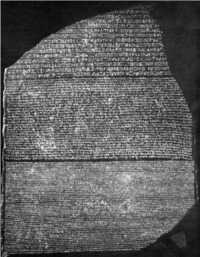
This inscribed stone takes its name from a small port of approximately 60,000 inhabitants, located in lower-Egypt, at the mouth of the western arm of the Nile. Here was discovered, in 1799, during the campaign of Egypt led by French General Bonaparte, a fragment of a stele now kept at the British Museum and known as « Rosetta Stone ».
Rosetta Stone is a deciphering tool whose discovery was of great importance for the study of antique Egypt. It helped to create Egyptology in the 18th century and to develop it in the 19th and 20th centuries. On this stone we can see the same text engraved in 3 different scripts: hieroglyphic (1), demotic (2) and Greek (3). These three scripts reproduce a decree issued in Memphis by Pharaoh Ptolemy V in 196 BCE. The deciphering of the hieroglyphs by the French searcher Jean-François Champollion in 1822 led to the interpretation of many documents of ancient Egyptian civilization.
The hieroglyphic text (1) is located at the top of Rosetta Stone, and this is unfortunately the less complete. In the middle of the Stone, the demotic (2) text is a cursive script of ancient Egypt (from the 7th century BC to the 5th century AD). This script is similar to the hieratic script used in the Ipuwer papyrus. The text in ancient Greek (3), at the bottom of the Stone, has been used to decipher the hieroglyphics of ancient Egypt, by comparison with the other texts.